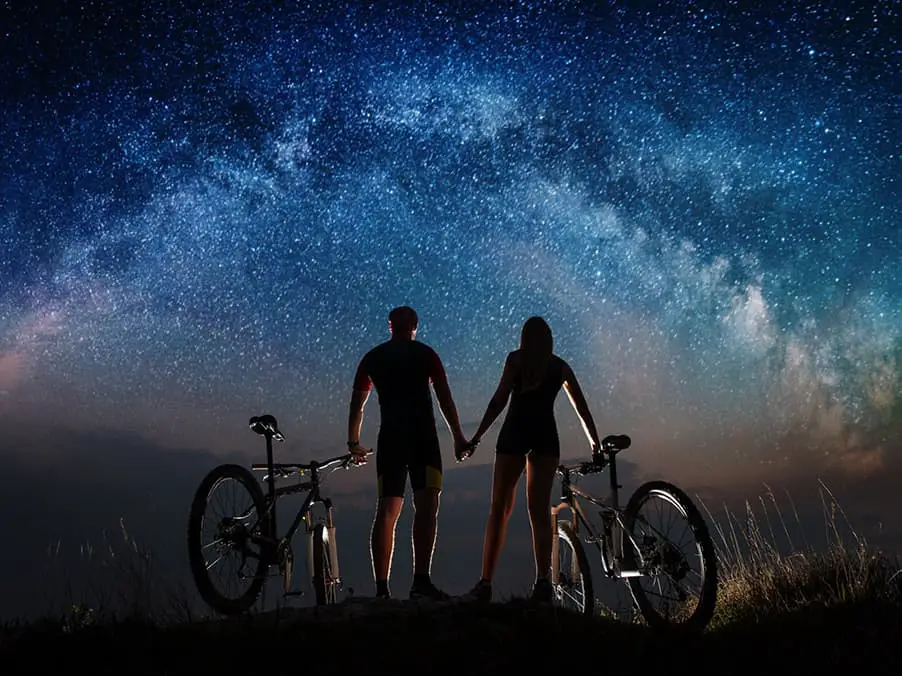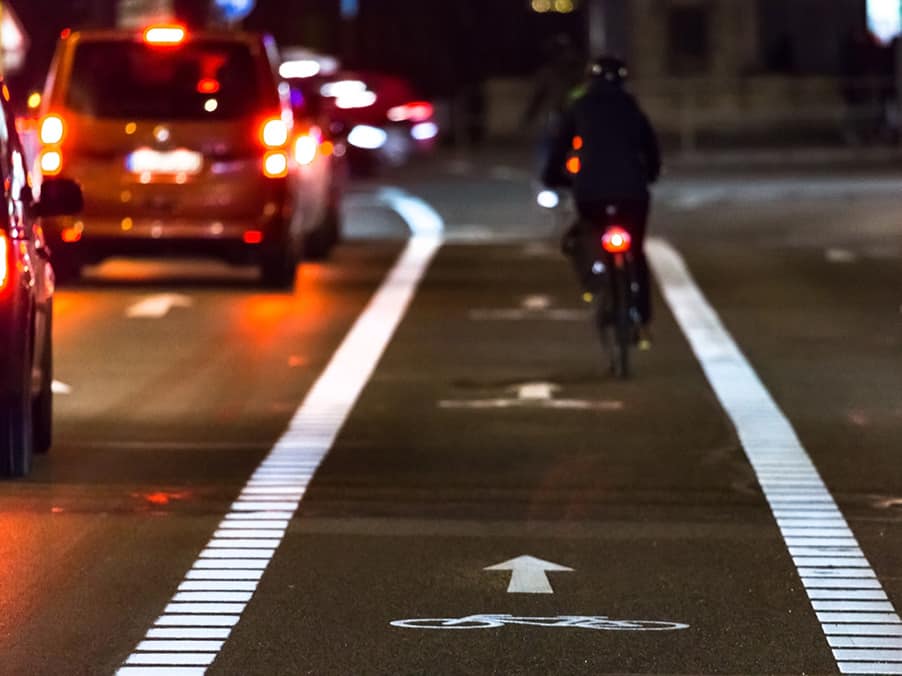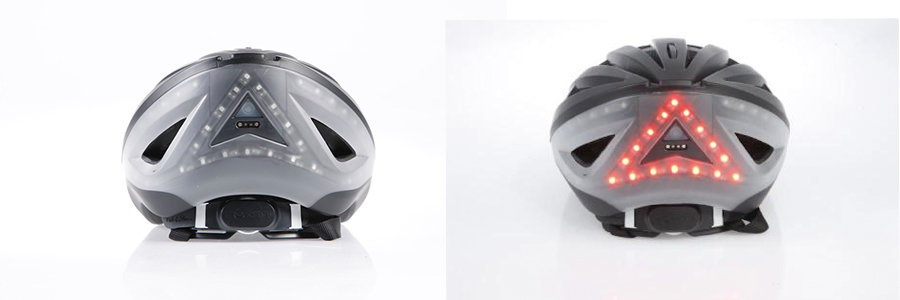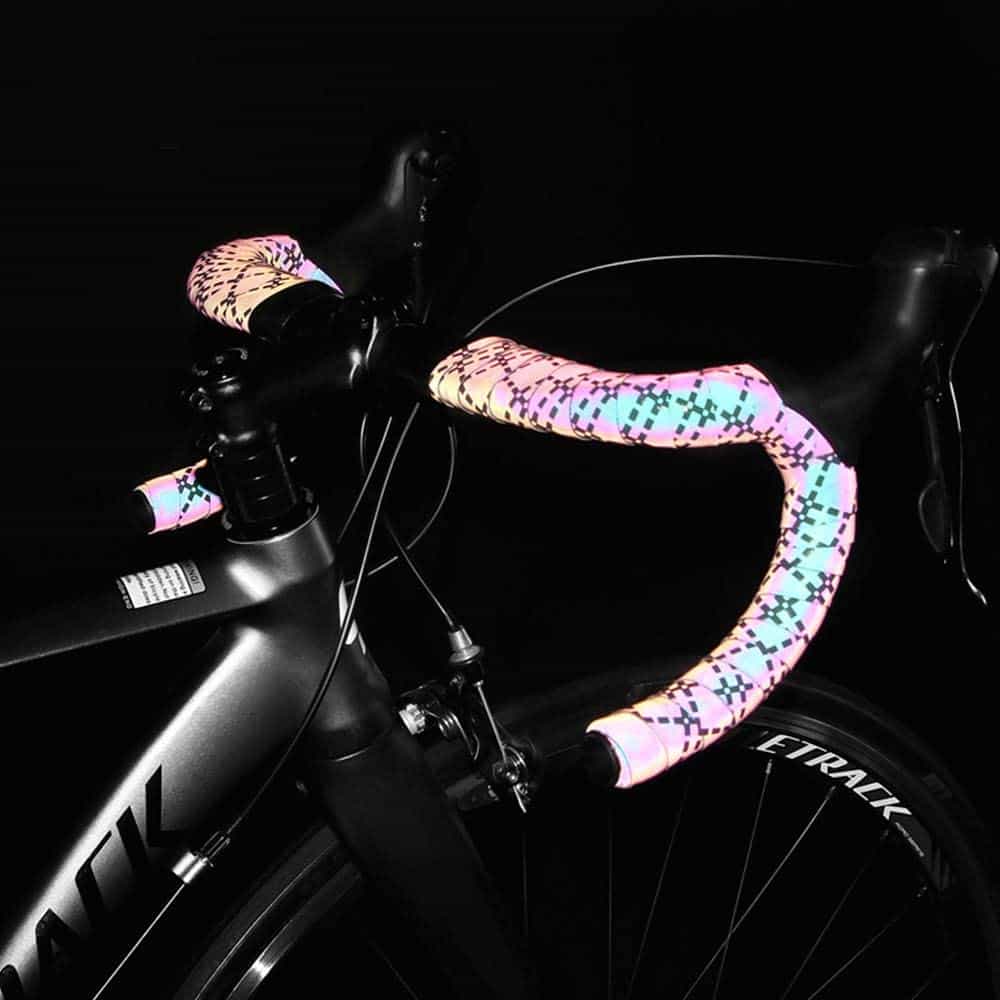
It is inevitable that at some point in your bike commuting life, you will be faced with the need to bike after the lights have gone out. Even if you can plan your working hours relatively well around the rise and fall of the sun, unforeseen issues will lead to you to bike commute at night.
When bike commuting at night it is important that you can see and BE seen by other road users!! It is the law to ride on the road with good bike lights fitted which is critical to keeping you safe at night. It also a good idea to wear high reflective clothing to complement your light set up.
To bike commute at night you will need:
- Knowledge of the laws of riding at night
- A good set of rechargeable lights, white light for the front, a red light for the rear
- Reflectors for your bike
- Reflective and high visibility clothing
Whilst bike lights are critical to your safety, and the safety of other road users, when bike commuting at night, there is more to it than to see and be seen. Knowing the law is important to understand how to stay safe but you also need to anticipate the potential hazards up ahead and take measures to prepare for the unexpected with less time to react due to reduced visibility.
Bike commuting at night can be intimidating for the beginner, this article highlights some key considerations and advice to keep you safe. In this article we cover:
- Bike Commuting at Night – Know the Law
- Is it Dangerous to Bike Commute at Night?
- Visibility – See and Be Seen
- Take Alternative, Well Lit Routes
- Read the Road
Bike Commuting at Night – Know the Law
According to Rule 60 of the Highway Code, at night your cycle MUST have white front and red rear lights lit. It MUST also be fitted with a red rear reflector (and amber pedal reflectors. Flashing lights are permitted but it is recommended that cyclists who are riding in areas without street lighting use a steady front lamp.
The Road Vehicles Lighting Regulations (RVLR) 13, 18 and 24 embed this rule in the Highway Code in UK law and so must be obeyed. Not only is this a good idea to keep you safe, but it is also a mandatory legal requirement which can lead to prosecution if not obeyed.
To conform with BS6102-3, any cycle that travels after sunset and in poor visibility should be equipped with:
- A white front light
- A red rear light
- A rear reflector
- Yellow (or amber) pedal reflectors, fitted at the rear and front of each pedal
While these are not necessary during the daytime, you can’t guarantee that you won’t ever travel after sunset or in situations of rain or fog. Therefore, it is recommendable to fit your bike with all of these to be ready in case of need.
The video below helps to explain this further.
Lights and reflectors not conforming to the BS, but conforming to a corresponding standard of another EC country and marked accordingly, are considered to comply as long as that standard provides an equivalent level of safety.
Lights are NOT required to be fitted on a bicycle at the point of sale so you will need to buy them in addition to your equipment. You are responsible for making sure they comply with the required standard. Visit our product page for light recommendations.
When you purchase your bike, they will be fitted with reflectors that do comply with the latest standards and regulations.
Is it Dangerous to Bike Commute at Night?
Intuitively, bike commuting at night, with reduced visibility for cyclists and motorist alike, seems more dangerous. However, it is difficult to draw this conclusion from the statistics alone.
The Royal Society for the Prevention of Accidents punished data in 2016 stating that 80% of biking accidents occurred in daylight. Obviously the number of cyclists out and about in daylight far exceeds those out at night so this statistic doesn’t give a full picture.
The data also shows that the most dangerous hours for cyclists are 15.00 to 18.00 p.m. and 08.00 to 09.00 on weekdays. However, cycling accidents in the dark are more likely to be fatal.
We have an article on bike commuting safety, which is definitely worth a read for a deeper understanding but to ensure the additional dangers at night, and the increased risk of fatality in the event of an accident, are understood we have some important information below so read on!
Visibility – See and Be Seen

Bike lights are not just to aid your visibility when bike commuting, whilst they are great for illuminating your path and spotting hazards, they also play a key role in making sure other road users can see you too.
Lights To See
These are the lights fit at the front of your bike, and they usually emit white light – either flashing or continuous. You will need them to illuminate the road in front of your and identify any possible obstacle. Therefore, they are usually much brighter than the ones at the rear, with lumens ranging between 100 and 200 for urban travels. However, if you are planning to cycle through a rural area, these lights can have as much as 1,600 lumens.
Lights To Be Seen
The lights to be seen are the ones located at the rear of your bike, and they are often orange or amber. These lights don’t need to be as bright as the front ones since they are designed to let other drivers and cyclists know about your presence on the road.
Can Lights be Too Bright?
It is important that your lights are good quality and provide the right level of lumens (brightness) for your needs. It is not always a case of ‘brighter is better’. You need to make sure your lights are not too bright to dazzle other road users, which could be unsafe.
The amount of lumens you need is based on the situation, you can read about lumens in more depth in this other article, but below are some guidelines on bike light brightness requirements:
| Situation | Lumens |
| Daytime Cycling | 100+ |
| Urban Cycling (well-lit) | 50-200+ |
| Rural Cycling (not as well-lit) | 400-600 |
| Trails and Mountain Biking | 600-1000 |
Flashing Lights vs Static Lights
There is some confusion over whether to comply with UK law lights must be continuous or whether flashing lights are required.
As a reminder from earlier in the article, in order to conform with BS6102-3, any cycle that travels after sunset and in poor visibility should be equipped with:
- A white front light
- A red rear light
- A rear reflector
- Yellow (or amber) pedal reflectors, fitted at the rear and front of each pedal
The law doesn’t stipulate whether lights need to be flashing or static and so you need to make a personal choice (or combine them if possible). You can use only flashing lights front and rear, as long as they are both capable of emitting at least 12 lumens, which most modern lights will not have a problem with. The light must also only flash between 60 and 240 times per minute (1–4Hz).
There are no statistics available which states the level of safety improvement, or otherwise of steady versus flashing lights, anecdotaly, flashing lights can distort depth perception, which is a disadvantage, but converslty a steady light can get lost in a see of other distracting light.
Our advice is that for city riding, a flashing light is adequate, and in a lot of cases, beneficial. If you are on dark roads then static lights are going to work best. Static lights on your bike, complimented by flashing alternatives is an effective setup.
Also, be aware that it’s illegal to show a red light at the front, or white light to the rear.
Test Your Lighting Setup
As a bike commuter, you will never know how well you are illuminated in various situations. It is a good idea to make sure you are visible to other road users. To do this, test your setup but getting a friend or family member to follow up through different lighting conditions – country lanes, city centres, towns, residential areas – your follower can give you feedback on your setup.
This way you can make sure your lights are angles correctly, and not dazzle other road users, and ensure your reflective choices are aadqquate for your commute.
Better to do this once to make sure you are well illuminated, than to find out the hard way, that you are not!!
Backup Lighting
Lights are not optional when bike commuting at night and as such, it is not good, if before you arrive at your destination, your batteries fail you. Most modern rechargeable lights have battery life in excess of 3 hours and hence this shouldn’t be an issue for most bike commute situations, but if you get caught short, you will be breaking the law completing your ride without lights.
It is worth having a back up system, easily deployable if this situation arrises. The easiest way is to double up on the same lights to increase your knowledge of fitting them so you can rapidly change them on your commute. However, lights can be expensive, and having a spare set, and potentially never use them may not be the approach you want to take.
Your backup lights can be cheaper than your main setup but still need to be reliable. We recommend the TEMINICE – USB Rechargeable Bike Light Set, which is a great option and very competitively priced and so doubling up this setup does not need to break the bank.
It’s More Than Just Lights You Need
In addition to lights, it is a good idea, although not a legal requirement, to be highly reflective to aid the chances of been seen on the road. High visibility and reflective accessories are complementary to your lighting setup.
Clothes can be bright reflective colours as well as containing materials that will reflect surrounding lighting, such as car headlights, effectively. Bright high visibility colours are not as effective at night and reflective materials are more beneficial.
This can be accomplished with reflective clothing, such as jackets, cycling jerseys and shorts with reflective additions or it can be accomplished with addition vests or bands.
I recommend the Firefly Buddy Reflective Vest and Bands as a great option. These coloured to be highly visible but also have reflective materials so can be good for daytime and nighttime bike commuting and kill two birds with one stone. These vests and bands can also go with any clothing set up for summer and winter months whereas reflective jackets would be too warm to wear in the winter.
We also recommend the LUMOS Kickstart Lite Helmet as an alternative option to the traditional helmet and are aimed directly at the bike commuter market. This helmet has added, built-in lights at the front and rear meaning you are much more visible on the road and these even have the option for signalling technology to communicate to other road users your intentions on the road which is a great additional feature.

Another great way to increase visibility is to use reflective tape to your bike. Reflective tape is cheap and comes in a number of colours so you can closely match your frame. In normal conditions, you can’t see the tape but illuminates at night in the path of car headlights.

This reflective handlebar tape is great to create a large area at the front of your bike that is reflective.
This is a great way to customise your bike while increasing visibility at night. It also is a way to be more reflective without having to pull on extra items of clothing that could be an issue in warmer weather.
Reflective bike tyres are also a great way to increase the visibility without having to carry extra items, the downside is that these only illuminate from a side-on view and ongoing or approaching traffic lights will not reflect off these surfaces.
Check out our products page for more information.
Take Alternative, Well Lit Routes
What could be an idyllic route during daylight hours, weaving through lovely countryside on sweeping country roads, can become treachourous come night fall and under the blanket of darkness.
Country lanes are usually less well maintained than city roads, resulting in having to avoid more pot-holes do not have additional street lighting and can have fast-moving traffic without the space to overtake safely. All of these factors lead to more danger than during daylight hours.
It may be worth finding an alternative route if possible, even if this takes you out of your way a little more than desired. Generally, cities and towns will be the best bet, although busier, the level of additional street lighting makes your commute less dangerous. Ambient light levels will be elevated and you are more likely to be seen by other motorists. Motorists are also more likely to expect bikes in a city or town.
If your route usually takes you along a riverside cycle-path or quite park it is advisable to avoid these areas too after dark if there are no other people around? Bad people are rare, not non-existent. If you wouldn’t walk somewhere alone at night, don’t cycle there alone. Stick to routes with people about instead.
It is also worth being prepared in case you have issues of this nature, a good personal alarm is recommended. We like this one from Amazon, cheap and effective.
Read the Road
When it is dark, you need to have a little more concentration to make sure you plan for any hazards up ahead. You will not be able to see as far, even with the brightest of lights, so you will have less time to react to upcoming pot-holes, or road blockages.
It is important to angle your front light to be able to see enough of the road surface in front as possible, without having too tilted that is dazzles and distracts ongoing vehicles. If you spot a pot hole, you will have less time to avoid it than usual so it is worth slowing down in these conditions. Erratic swerving is not the best idea when visibility is hindered.
Cycle Scheme points out that for reference: at 15mph (24km/h), you’ll be travelling at almost 7 metres per second. On unlit lanes, you’ll want a strong beam that lights up the road at least 10 metres ahead. In areas of excellent street lighting, less powerful light will suffice.
Summary
Bike commuting at night requires you to be extra vigilant and to comply with all the regulations, guidance and law in order to keep you as safe as possible. Whilst there is an increased risk of issues and accidents at night, it is not enough of a reason to stop bike commuting.
A little planning and preparation can get you ready for bike commuting at night and we encourage you to do so!!
Let us know if you have any other tips and advice for our readers.
